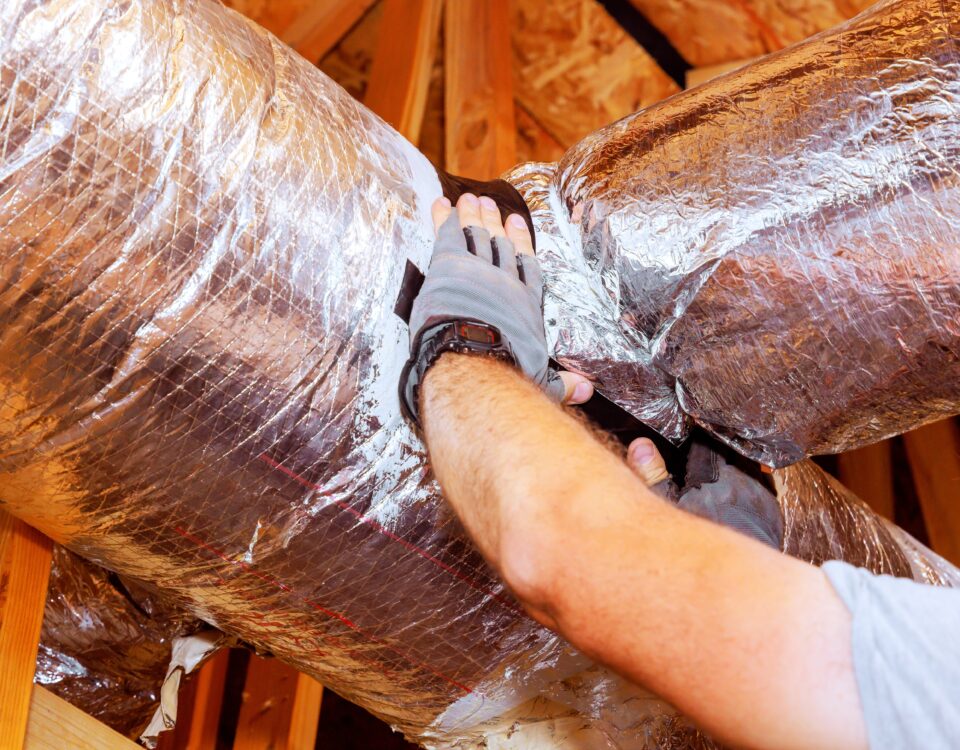Navigating Building Regulations: What You Need to Know About Ductwork Compliance

When it comes to modern building services, ductwork systems are often the unsung heroes. From maintaining indoor air quality to enabling efficient heating, ventilation and air conditioning (HVAC), properly designed and installed ductwork is crucial to a healthy, comfortable space. But more than just function, it must also comply with rigorous building regulations.
SEWS Ductwork, based in Essex, is a trusted name in ductwork design, manufacture, installation and replacement. With over 25 years of industry experience, we provide bespoke ducting solutions for commercial, industrial, and residential projects across the South East. Our commitment to quality and compliance ensures that every installation meets the latest standards and delivers long-term reliability.
In this blog post, we’ll help you unravel the often complex world of ductwork compliance and building regulations. Whether you’re a property developer, project manager, facilities coordinator or simply a curious homeowner, this guide will clarify your obligations and show how SEWS Ductwork can support you every step of the way. Get in touch with us today for more information!
Navigating Building Regulations: What You Need to Know About Ductwork Compliance
When installing or altering ductwork in a building, it’s not just about getting the air from A to B. Every component must align with UK Building Regulations. These legal standards exist to ensure that properties are safe, energy-efficient, and environmentally sound.
Understanding the Basics
Let’s start with a quick look at the core Building Regulations that relate to ductwork:
- Part F (Ventilation) – Ensures that buildings are adequately ventilated, reducing the risk of condensation, damp, and indoor air pollution.
- Part L (Conservation of Fuel and Power) – Focuses on energy efficiency, mandating that duct systems must be insulated and air-tight to reduce heat loss and energy consumption.
- Part B (Fire Safety) – Requires fire-resistant ducting and appropriate fire dampers in designated locations to limit the spread of smoke and flames.
- Part E (Resistance to Sound) – Ensures that duct systems don’t create or transmit excessive noise between rooms or properties.
Each of these elements must be addressed during design, manufacture and installation.
Compliance Considerations for Ductwork
Here are the key areas where compliance plays a major role:
- Ventilation Rates
Every habitable space must receive a minimum amount of fresh air per hour. Mechanical ventilation systems with heat recovery (MVHR) and extractor fans must be sized correctly and installed in accordance with Part F guidelines.
- Duct Insulation
To comply with Part L, ductwork must be insulated to prevent heat loss (or gain in cooling systems). This also prevents condensation on cold ducts in warm spaces. Thickness and type of insulation vary based on system type and duct location.
- Air Leakage
All ductwork must be sealed properly using appropriate tapes and sealants. Leakage rates are measured in litres per second per square metre of duct surface. High leakage can result in regulatory non-compliance, increased energy bills and reduced system efficiency.
- Fire-Safe Installation
Under Part B, fire-rated ductwork and dampers are required when ducts pass through fire compartments (e.g. floors or walls). Materials must meet British Standards (BS EN 1366), and fire integrity times should be documented clearly.
- Acoustic Control
Poorly installed ductwork can become a channel for noise. To comply with Part E, systems may need acoustic lagging or silencers to limit transmission. Especially critical in residential blocks, hospitals and schools.
- Access and Maintenance
Access panels should be included at key points along the duct route for regular cleaning and maintenance. This helps maintain hygiene standards and airflow performance.
- Condensation Control
Uninsulated ducts or poorly positioned ones may cause condensation issues, leading to mould or structural damage. Correct placement, gradient for drainage and insulation are all regulatory considerations.
- Documentation and Commissioning
Proper documentation, including performance test results, commissioning reports and manufacturer data, is essential for proving compliance. This is particularly important for sign-off by Building Control or third-party assessors.
Ductwork compliance is not optional—it’s a legal requirement. Non-compliant systems can delay project sign-off, increase long-term costs, and even pose serious health and safety risks. Working with a knowledgeable provider like SEWS Ductwork helps keep your project aligned with the latest legislation.
The Importance of Ductwork Compliance
You might be wondering – why does ductwork compliance really matter? Isn’t it just a matter of installing some metal tubing and turning on the fans? Not quite. There are deeper implications for safety, sustainability, and system performance.
- Health and Indoor Air Quality
Poorly designed or non-compliant systems can lead to stagnant air, moisture buildup and mould, affecting the respiratory health of occupants. Properly compliant systems ensure constant airflow, which supports a healthier environment and helps control humidity levels.
- Fire Safety
Ducts act as conduits for smoke and fire. If not correctly sealed or fitted with dampers, they can accelerate the spread of fire throughout a building. Adhering to fire safety standards, such as installing certified fire dampers, creates crucial barriers that limit damage and protect escape routes.
Energy Efficiency
Ductwork that leaks, lacks insulation or is poorly routed will force your HVAC systems to work harder. This increases your energy bills and your carbon footprint. Compliant systems reduce wastage and improve operational efficiency, often resulting in significant long-term savings.
- Noise Reduction
A compliant duct system is a quiet one. Without the right design and materials, you might hear every fan motor, vibration and conversation from one room to another. Using acoustic insulation, silencers, and properly supported ducting reduces unwanted noise transmission throughout the building.
- Legal and Financial Risks
Non-compliance can lead to fines, rework costs, project delays, or even legal action in the event of a failure or incident. Ensuring compliance from the outset minimises liability and avoids the expense and hassle of rectifying problems after installation.
- Future-Proofing and Certification
Meeting today’s regulations is just the start. With growing attention on building sustainability and energy use, systems that meet or exceed current standards are more likely to remain compliant in the future. Having certified and documented systems makes future upgrades, audits, and property sales smoother and more transparent.
- Tenant and User Satisfaction
Whether you’re managing a commercial facility or a residential property, tenants expect comfort and reliability. Well-regulated duct systems support stable temperatures and fresh air circulation, improving quality of life and occupancy retention.
Ensuring your ductwork meets regulations is more than an administrative task—it’s a cornerstone of a safe, efficient and sustainable building. Compliance protects people, property and your investment in the long run—and with the right expertise, it can be a seamless part of your project delivery.
How can SEWS Ductwork help?
At SEWS Ductwork, we don’t just manufacture and install ducting—we help ensure your entire system is regulation-compliant from start to finish.
Our Services Include:
- Bespoke Ductwork Manufacture
We create custom ducting solutions using galvanised, stainless steel, and PVC materials to suit every application. Each component is precision-made to meet both your project requirements and relevant British Standards.
- Professional Installation
Our expert installation teams ensure that every section of ducting is securely fitted, sealed, insulated and tested. We work to detailed design plans and can assist with system layouts that maximise efficiency while maintaining full compliance.
- Fire Dampers and Smoke Control Systems
We supply and install fire-rated ductwork and control systems to maintain compartmentation and fire integrity in accordance with Part B. Our team is trained in fitting and commissioning fire dampers to manufacturer and regulatory standards.
- Duct Replacement and Upgrades
Old or inefficient ductwork? No problem. We can assess your existing system and recommend upgrades or full replacements that bring it in line with the latest regulations, improve airflow and reduce energy consumption.
- Maintenance Access Solutions
We fit access panels, dampers and inspection hatches to allow for regular maintenance and compliance checks. Whether it’s a new build or retrofit, we’ll help future-proof your system.
- Site Surveys and Compliance Reports
We offer site surveys and can work closely with your building control officer to ensure all ductwork complies with local authority requirements. We provide all necessary documentation and certification.
- Fast Turnaround Times
Time is often critical. That’s why we offer quick fabrication lead times and rapid response installation for urgent projects—all while maintaining our high standards.
Let SEWS Ductwork take the stress out of compliance. Whether you’re planning a new build, refurbishment or replacement project, our experienced team is ready to deliver tailored solutions that meet every regulation efficiently and affordably. Get in touch today to schedule a consultation, request a quote, or speak to one of our ductwork specialists.
Why choose SEWS Ductwork?
With a proven track record across commercial and residential developments, we understand the intricacies of compliance. Our engineers are up to date with the latest legislation, ensuring that every project—big or small—is completed to the highest quality and compliance standards.
In Conclusion: Your Ductwork, Done Right, First Time
Navigating building regulations doesn’t have to be daunting. With the right support, it becomes a straightforward part of your project delivery. At SEWS Ductwork, we combine technical expertise with practical experience to help you achieve total compliance with confidence.
So whether you’re designing a new system, updating an old one or simply want to ensure your existing ductwork meets the latest regulations, we’re here to help.
Ready to breathe easy with fully compliant ductwork? Contact SEWS Ductwork today for expert advice, custom ducting solutions and professional installation services.
FAQs
- Do all ductwork systems need to comply with building regulations?
Yes. Whether for residential or commercial use, ductwork must meet various building regulations, including Parts F, L, B and E.
- What happens if ductwork doesn’t meet compliance standards?
Non-compliance can result in fines, project delays, rework costs or rejection by Building Control.
- How do I know if my ductwork is fire-rated?
Fire-rated ductwork will be labelled and documented with its fire-resistance level. Always check manufacturer specifications.
- Is duct insulation always required?
Insulation is generally required under Part L to reduce heat loss and prevent condensation, especially in unheated spaces.
- What type of materials are compliant for ducting?
Galvanised steel, stainless steel and certain types of PVC are commonly compliant when installed correctly.
- Can I use flexible ducting in my system?
Flexible ducting is allowed in some applications, but it must still meet airflow and fire safety standards.
- Who is responsible for ensuring compliance?
The duty typically lies with the building owner or project manager, but your contractor must also be fully aware and compliant.
- How often should ductwork be inspected?
Commercial systems should be inspected at least annually. Regular checks help maintain compliance and performance.
- Are there energy efficiency targets for ductwork?
Yes. Part L requires systems to minimise energy loss through air leakage and poor insulation.
- Can SEWS Ductwork help with documentation for Building Control?
Absolutely. We provide full documentation, test results and certification as part of our service.
Let’s Get Started, Contact SEWS Ductwork Today
If you’re planning a ductwork project and want peace of mind that everything is compliant, efficient and expertly installed, SEWS Ductwork is the partner you need. From fabrication to final inspection, we’re with you every step of the way.

